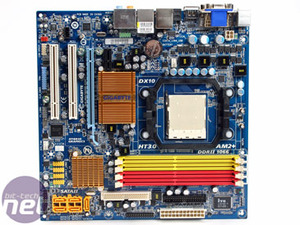
Gigabyte GA-MA78GM-S2H
Manufacturer: GigabyteUK Price (as reviewed): £58.75 (inc. VAT)
While we did a quick news piece last month featuring this board, things have changed ever so slightly on the retail release – for starters, we finally have a proper box bundle which includes:
- Two SATA cables,
- IDE and floppy cables
- Rear I/O panel
- Manual and Driver CD
Board Features
- Support for socket AM2/AM2+ processors (HyperTransport 1.0 and 3.0) including AMD Phenom, Athlon 64 FX, X2 and Sempron
- AMD 780G north bridge
- AMD SB700 south bridge
- Four 1,066MHz/800MHz 1.8V DDR2 DIMM slots supporting up to 16GB of memory
- Realtek ALC889a 7.1 channel High-Definition audio codec with support for DTS NEO:PC
- Realtek RTL8111C PCI-Express Gigabit Ethernet
- One PCI-Express 2.0 x16 slot
- One PCI-Express 2.0 x1 slot
- Two PCI slots
- Five SATA 3Gbps and one eSATA with support for RAID 0, 1, 0+1
- One IDE port
- Texas Instruments IEEE139a Firewire controller
- 12 USB 2.0 ports
The board is well featured – the four DDR2 slots allow for future upgrades, and two PCI slots give you ample legacy support for those upgrading on the cheap. The cooling has changed to include a very low profile north bridge heatsink that allows longer PCI-Express x1 cards to be installed, but it also leaves the heatsink far hotter – actually too hot to touch. The board is still perfectly stable, but we’re not hugely thrilled with the change – in contrast I’ve been using the engineering sample with its larger heatsink in my own home theatre PC for the past few weeks and it barely even gets warm. Gigabyte insists that this isn't cost related and the heatsink still conforms to the thermal specification of the chipset.
Thanks to all this though the CPU socket has a lot of space around it, even if the memory slots are quite close, the low profile north bridge heatsink leaves plenty of room overhead.
The south bridge uses an even smaller low profile heatsink, but in contrast this one doesn’t even get that warm. The layout on the Gigabyte-blue PCB is quite good but not wonderful – all the pin-outs are colour co-ordinated and well placed at the bottom of the board, except for green front panel audio connectors which are put behind the rear I/O. Like we found with some of the Gigabyte (E)P35 boards, installing various graphics cards makes you lose SATA ports.
A single slot graphics card voids one, an ATI Radeon HD 3870 kills two slots and a larger card like a Nvidia GeForce 8800 GTS 512 will stop you from using three out of five – that’s not exactly brilliant, if we’re honest. Mind you, this board is designed with its IGP or Hybrid CrossFire in mind, so a much shorter Radeon HD 3450 card won’t interfere in the same way.
Another awkward placement is the IDE slot – and why is the LPT printer port even included anymore? Let alone have it taking up prime real estate at the very edge of the board where the IDE slot should be. Instead it’s nestled between half a dozen power regulation components. The board features a standard four phase CPU power regulation, however unlike the usual Gigabyte boards this doesn’t feature all solid state capacitors and Ultra Durable branding (as is indicated by the “-S2H” nomenclature), and there’s also no support for Dynamic Energy Saver technology either.

MSI MPG Velox 100R Chassis Review
October 14 2021 | 15:04










Want to comment? Please log in.